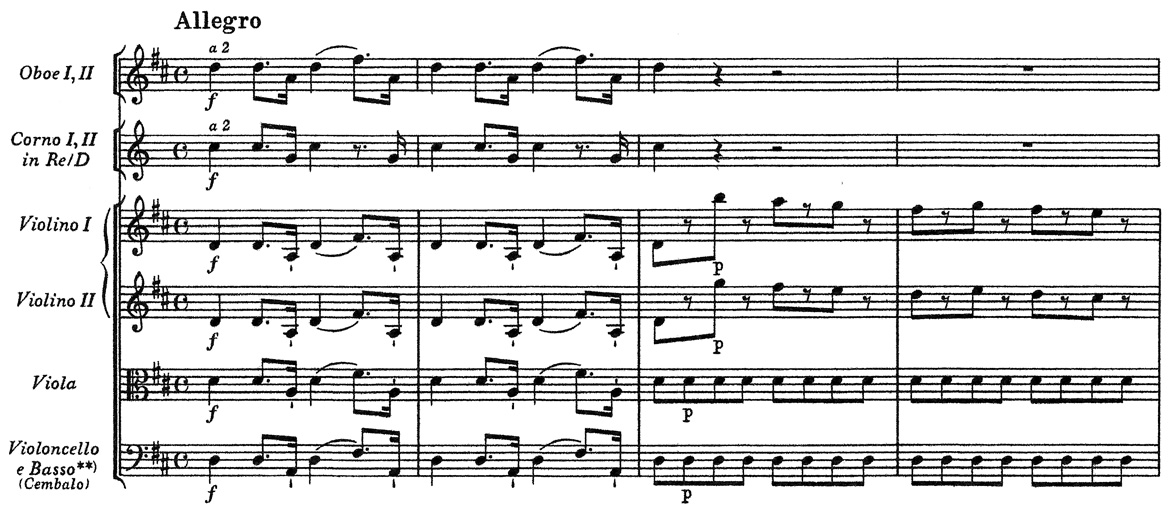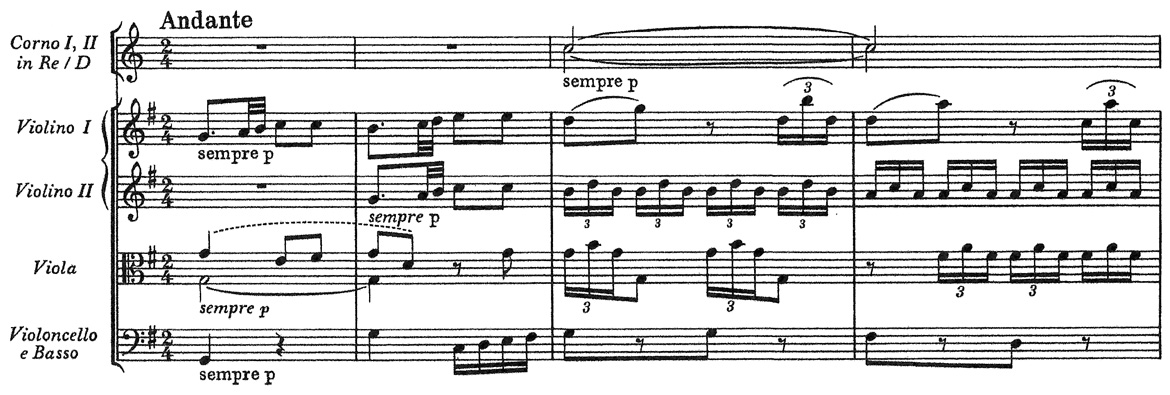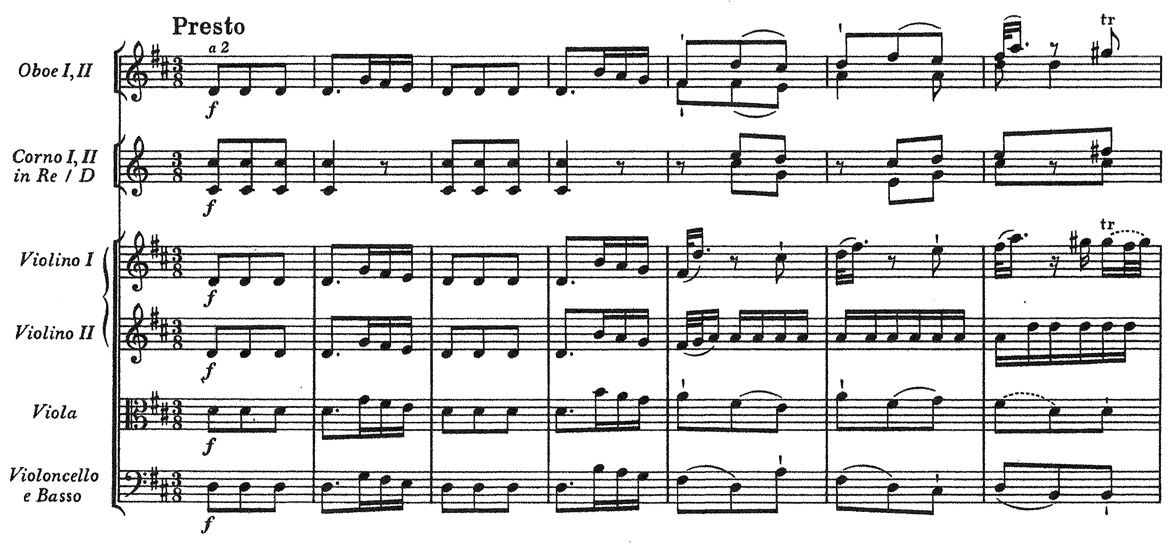Wolfgang Amadeus Mozart
Symphony No.4 in D major, K.19
Media Review / Comparison
2014-12-04 — Original posting
2016-07-29 — Brushed up for better readability
Table of Contents
Introduction / The Recordings
This posting is about the Symphony No.4 in D, K.19, by Wolfgang Amadeus Mozart (1756 – 1791), of which I currently have two recordings:
- Christopher Hogwood / The Academy of Ancient Music (1982)
- Jaap ter Linden / Mozart Akademie Amsterdam (2001)
Both these recordings are recent acquisitions on CD. In my LP collection, I only had Karl Böhm’s complete Mozart symphony recording, and I’m not particularly eager to listen to that again…
Background, About the Composition
Wolfgang Amadeus Mozart (1756 – 1791) wrote this symphony in 1765, at the age of 9; it actually is his second “official” symphony (Nos.2 and 3 were erroneously identified as Mozart’s). Apparently, the manuscript of the score is lost, but a set of parts written by Mozart’s father, Leopold Mozart (1719 – 1787) has survived. While this sounds like a safe source, it leaves open questions, as it is probably not clear what was the composer’s intent, and which part his father played in “fixing up” his son’s notation. Further editorial “corrections” may well have introduced additional distortions. One such question mark is with the first movement, which stunned me when I was preparing for a concert in which this was going to be played…
The Movements
The Symphony No.4 in D, K.19 has three movements:
I. Allegro (4/4)
78 bars, no repeats. According to Wikipedia, this movement starts with the following main theme:
This is indeed what I heard when listening to the recording with Christopher Hogwood. I’m sure older recordings, such as Karl Böhm etc. sound the same. The above is also shown in the Köchel catalog from 1979). However, the newer recording with Jaap ter Linden sounded rhythmically completely different:
This is the notation in the Neue Mozart Ausgabe (1984), without the extra, unnecessary ties which completely alter the face of this theme. I suspect that up till recently, commonly used editions carried those extra ties. I can’t say the melody sounds bad with these ties. Neither option sounds “wrong”, but without the ties, the melody has more of a galloping trait that (in my opinion) fits the subsequent dancing nature of the movement.
If research shows that Mozart didn’t write these ties, I think we should stick with the version without. In a concert in Zurich that I attended recently, Sir Roger Norrington also featured the movement in the second version above. The piece is a rudimentary sonata movement. The exposition has no repeat signs, and there is only a fragmentary recapitulation section. One detail to note: in bars #45/46 the exposition comes to a conclusion with a cadence in A major. Mozart chose to surprise / shock the audience with a sudden fp on a A# (in unison) on the second beat, leading to B minor for two bars — a typical Mozart joke!
II. Andante (2/4)
19 + 26 bars, both parts repeated. The second movement starts with the following bars:
A wonderfully calm, serene movement; the semiquaver triplet movements make it sound as if it was in 12/16 time. The other feature which stands out are frequent 2-to-4-bar resting notes in the horns and/or the first violins. Especially on the violins, historically informed (HIP) playing without vibrato makes these stand out even more.
III. Presto (3/8)
42 + 64 bars, both parts repeated. The last movement starts withA joyful, virtuosic movement — and not without challenges for the orchestra!
The Interpretations
Both recordings below are historically informed and were recorded on period instruments:
Christopher Hogwood / The Academy of Ancient Music
Mozart: The Symphonies
Christopher Hogwood / The Academy of Ancient Music
Decca / L’oiseau-lyre 452 496-2 (19 CDs, stereo); ℗ 1979 – 1986 / © 1997
Booklet: 127 pp. e/f/d/i

On the Artists
In the years 1978 – 1985, Christopher Hogwood and The Academy of Ancient Music with concert master Jaap Schroeder (1925 – 2020) recorded not just all of Mozart’s symphonies, including works with doubtful authenticity (53 compositions) and alternate versions (in particular, of K.385 / “Haffner” and of K.550 / G minor), but also K.444 (Symphony No.37 in G, actually by Michael Haydn, with an introduction by Mozart), as well as the march in D, K.408/2, the minuet in A, K.61g, and the six serenades K.100, 185, 203, 204, 250 (“Haffner”), and K.320 (“Posthorn”).
Where available at the time of the recordings, Hogwood used the “Neue Mozart Ausgabe” (New Mozart Edition), completed in 1984. For this symphony, unfortunately, this was not the case, see above. Compared to the recording below, the sound is a bit thinner / lighter / sharper, yet less transparent, more distant and clustered. For the early symphonies, Hogwood directs the ensemble from a harpsichord (for the late works he switches to a fortepiano). But the harpsichord sound is totally inconspicuous, hardly audible at all (the music is not meant to sound like a harpsichord concerto, after all).
Notes on the Movements
I. Allegro (4/4)
Duration: 2’10”, 1/4 = 154
Hogwood is slightly faster than Jaap ter Linden, the movement here has more momentum; unfortunately, this is with the old reading, as the New Mozart Edition wasn’t available at the time of the recording.
II. Andante (2/4)
Duration: 3’44”, 1/4 = 50
Compared to Jaap ter Linden, the articulation in the strings is broader, more portato, which also affects the transparency.
III. Presto (3/8)
Duration: 3’05”, 1/8 = 222
If one listens carefully, one can occasionally hear the harpsichord (I personally would have preferred to hear a bit more of that). But that equally applies to the recording below.
Overall Duration: 8’58”
Rating (see above for details): 4.0 (4 / 4 / 4) — A good recording, though I definitely prefer Jaap ter Linden for this symphony.
Jaap ter Linden / Mozart Akademie Amsterdam
Mozart: Complete Symphonies
Jaap ter Linden / Mozart Akademie Amsterdam
Brilliant classics 94295 (11 CDs, stereo); © 2011
Booklet: 23 pp. English

On the Artists
This is the more recent recording, made in 2001 / 2002, released in 2011: Jaap ter Linden and the Mozart Akademie Amsterdam included only symphonies, and “just” those works which are known to be authentic. That means, Symphonies No.1, 4 – 36, 38 – 41, the Symphony in F, K.19a, and the second version of the Symphony in G minor, K.550. Jaap ter Linden had the obvious advantage of having access to the New Mozart Edition for all symphonies, including of course this one, see above.
At least for this early symphony, the recording features a warmer, somewhat darker sound (with maybe more reverberation), more spatial resolution and transparency, a “closer” sound, overall. Some might call the sound too dark / heavy (slightly over-acoustic). But I think this is more than compensated by the better transparency, the additional differentiation for second / third voices and the wind instruments. As in the recording with Hogwood, the orchestra here includes a harpsichord (Jaap ter Linden is “just” conducting), and also here, the instrument is hardly audible. It inconspicuously reinforces the rhythmic skeleton of the music. Unfortunately, the booklet has almost no information on the instrumentation (other than referring to “period instruments”), let alone information on orchestra size for specific symphonies.
Notes on the Movements
I. Allegro (4/4)
Duration: 2’33”, 1/4 = 148
Lacks some of the drive of Hogwood’s recording: the tempo is slightly slower here. But that is more than outbalanced by a more careful and detailed articulation and transparency, some nice agogics (e.g., the slight slowdown for the B minor section in bars #47 – 49!).
II. Andante (2/4)
Duration: 3’47”,: 1/4 = 52
I like the lighter, staccato articulation in the second violins (indicated by Mozart with vertical bars. It is possible that these markings were missing in the older scores). Also, the fp, especially in the horns, are very nice and articulated, and I like the gut string sound (the microphones must have been placed much closer than for Christopher Hogwood’s recording).
III. Presto (3/8)
Duration: 3’12”, 1/8 = 216
In my opinion, the articulation is better here, more careful and differentiated. This is likely the benefit of better recording technique, but also of the very slightly slower tempo.
Overall Duration: 9’21”
Rating (see above for details): 5.0 (5 / 5 / 5) — An excellent recording. The only possible criticism here might be the somewhat bulky sound / acoustics.
Addendum
As mentioned above, Mozart’s Symphony in D, K.19 was featured in a concert at the Tonhalle in Zurich, on 2014-11-25, with Sir Roger Norrington and the Zurich Chamber Orchestra. See my concert review for Bachtrack.com. As this is in German, I have written up a separate, more extended review in the posting “Norrington & Albrecht Mayer in Zurich, 2014-11-25“.










